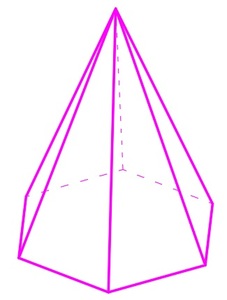A regular pyramid
 The right pyramid shown in the figure has a height of
1
5
and a base of a regular hexagon with side length
6
. If the total surface area of the pyramid can be expressed as
x
3
+
y
7
, where
x
and
y
are integers, find
x
+
y
.
The right pyramid shown in the figure has a height of
1
5
and a base of a regular hexagon with side length
6
. If the total surface area of the pyramid can be expressed as
x
3
+
y
7
, where
x
and
y
are integers, find
x
+
y
.
The answer is 162.
This section requires Javascript.
You are seeing this because something didn't load right. We suggest you, (a) try
refreshing the page, (b) enabling javascript if it is disabled on your browser and,
finally, (c)
loading the
non-javascript version of this page
. We're sorry about the hassle.
2 solutions
Area of the regular hexagonal base: A 1 = 6 ⋅ ( 4 6 2 3 ) = 5 4 3 .
Area of the six slanted faces: A 2 = 6 ⋅ ( 2 1 ⋅ 6 ⋅ 1 5 2 + ( 3 3 ) 2 ) = 1 0 8 7 .
Hence, x = 5 4 , y = 1 0 8 ⇒ x + y = 1 6 2 .
Let the length of the slanting side of the isosceles triangle be a . Then a = 1 5 2 + 6 2 = 2 6 1 = 3 2 9 . By Heron's formula , the area of an isosceles triangle is:
A △ = ( a + 3 ) ( 3 2 ) ( a − 3 ) = 9 ( a 2 − 9 ) = 9 ⋅ 9 ⋅ 2 8 = 1 8 7 Note that s = 2 2 a + 6 = a + 3
The area of the base hexagon is that of six equilateral triangles with side length 6 . Then A hex = 6 ⋅ 2 6 2 sin 6 0 ∘ = 5 4 3 .
Therefore the total surface area A = A hex + 6 A △ = 5 4 3 + 1 0 8 7 . ⟹ x + y = 5 4 + 1 0 8 = 1 6 2 .